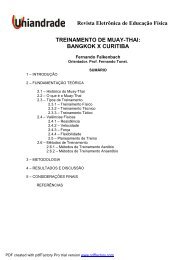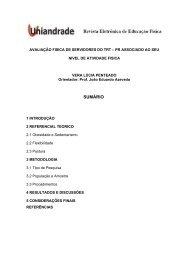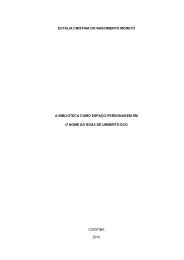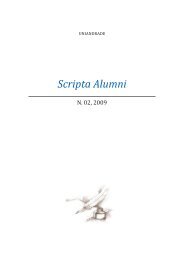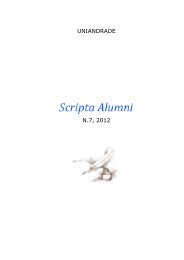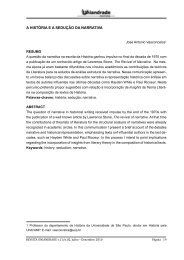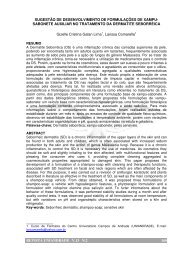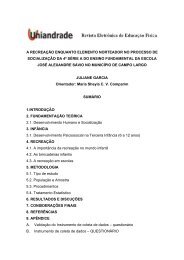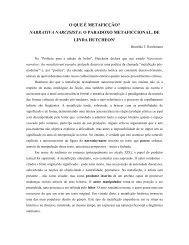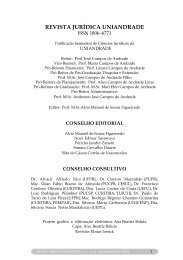Scripta 9_2_link_final.pdf - Uniandrade
Scripta 9_2_link_final.pdf - Uniandrade
Scripta 9_2_link_final.pdf - Uniandrade
You also want an ePaper? Increase the reach of your titles
YUMPU automatically turns print PDFs into web optimized ePapers that Google loves.
SHAKESPEARE EM PORTUGUÊS DO BRASIL:<br />
AS TRADUÇÕES EM VERSO DE JOSÉ ROBERTO O’SHEA<br />
Resumo: Este artigo faz, inicialmente,<br />
uma apresentação da estratégia global<br />
adotada por José Roberto O’Shea nas<br />
três primeiras traduções anotadas que<br />
realizou de peças de William Shakespeare:<br />
Antônio e Cleópatra, Cimbeline, rei da<br />
Britânia e O conto do inverno. A seguir,<br />
dedica-se a examinar um aspecto formal<br />
dessa estratégia, que é uma métrica<br />
ancorada em decassílabos brancos ou<br />
rimados, de acordo com a distribuição<br />
do original. A análise focaliza<br />
especialmente as soluções encontradas<br />
pelo tradutor para recriar em português<br />
o pentâmetro iâmbico branco, que é o<br />
metro mais característico da poesia<br />
dramática shakespeariana. A partir dos<br />
trechos analisados pode-se observar que<br />
a tendência de O’Shea tem sido a de<br />
recorrer cada vez menos aos metros<br />
pouco convencionais. Sua escolha do<br />
decassílabo com acento na quinta sílaba,<br />
afirmada no paratexto de Antônio e<br />
Cleópatra, parece ter sido deixada de lado<br />
nas duas traduções seguintes, em que<br />
predominam os versos de corte mais<br />
tradicional, com acento tônico na sexta<br />
sílaba, caso do martelo-agalopado e o<br />
heroico.<br />
Paulo Henriques Britto<br />
phbritto@hotmail.com<br />
Marcia A. P. Martins<br />
mmartins@puc-rio.br<br />
Abstract: The article begins with a<br />
presentation of the global strategy<br />
adopted by José Roberto O’Shea in his<br />
first three annotated translations of<br />
Shakespeare’s plays: Anthony and<br />
Cleopatra; Cymbeline, King of Britain; and<br />
The Winter’s Tale. Following that, a<br />
specific formal aspect of his strategy is<br />
discussed: his use of decasyllables,<br />
unrhymed or rhymed in accordance with<br />
the original. Particular emphasis is given<br />
to the different ways how O’Shea<br />
translates blank verse, the unrhymed<br />
iambic pentameter that is the most<br />
characteristic meter of Shakespearean<br />
drama. The passages analyzed indicate<br />
that in his later translations O’Shea relies<br />
less and less on unconventional stress<br />
patterns. His tendency to use<br />
decasyllables stressed on the fifth syllable,<br />
which he comments on his paratext to<br />
Antony and Cleopatra, seems to decrease<br />
in the two later translations, where the<br />
predominant forms of the decasyllable<br />
are the more traditional martelo-agalopado<br />
and heroico, stressed on the sixth syllable.<br />
Palavras-chave: Shakespeare. Tradução teatral. Versificação. Métrica.<br />
Key words: Shakespeare. Drama translation. Versification. Metrics.<br />
<strong>Scripta</strong> <strong>Uniandrade</strong>, v. 9, n. 2, jul.-dez. 2011 127



